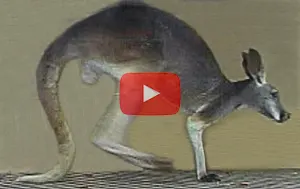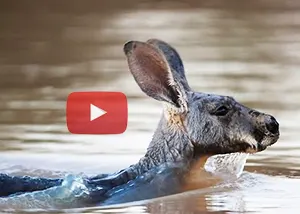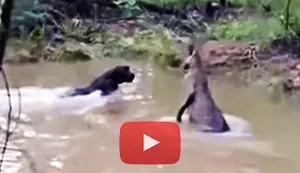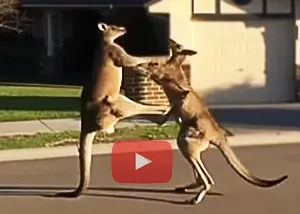Kangaroos: Australia’s Most Iconic Animal
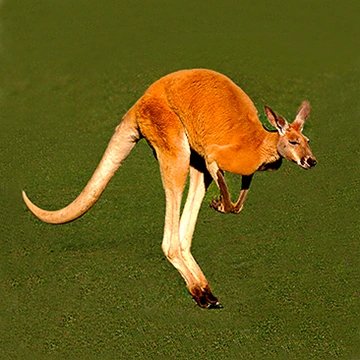
Contents
What Is a Kangaroo?
Kangaroos are large, fast, and agile hopping herbivorous marsupials native to Australia. They have distinctive triangular bodies, large hind legs, small forelimbs, and a long, thick tail. Their fur colour can vary from orange-brown to grey to dark brown. Kangaroos can grow to 2 meters in height and weigh 90 kilograms. They can hop at speeds of up to 70 kilometres per hour and leap as high as 4 meters. Male kangaroos are larger than females, and only female kangaroos have a pouch in which they carry their young. Kangaroos cannot hop at low speeds. So, they walk on five legs! This unique way of walking is called pentapedaling locomotion.
How Did the Kangaroo Get its Name?
Origin of the Name Kangaroo
The word “kangaroo” originated from the Guugu Yimithirr aboriginal people of northeast Queensland. In their language, it meant "large black hopping animal". Captain James Cook was the first European to describe the kangaroo and translate the aboriginal word into an English name.
Other Fun Kangaroo Names
• Male Kangaroo: Boomer, Bucks, Old Man, and Jacks.
• Female Kangaroo: Flyer, Jills and Doe.
• Baby: Joey
• Group of Kangaroos: Mob, Court, Troupe.
Types of Kangaroos
Kangaroos belong to the scientific animal group Macropodidae (Macropod means 'big foot’ in Greek). But only the four largest species in this group are called kangaroos.
They are:
• Red Kangaroo – Largest of all kangaroos, males can stand over 2 meters tall.
• Eastern Grey Kangaroo – Most commonly seen, especially in eastern Australia.
• Western Grey Kangaroo – Found in southern and south-western Australia.
• Antilopine Kangaroo – The only species that lives mainly in tropical areas.
How Kangaroos Hop So Far and Fast?

Kangaroos are built to bounce. Their massive leg muscles and stretchy tendons store energy like a spring, allowing them to hop and cover long distances effortlessly. Interestingly, they use less energy the faster they hop.
Fun Kangaroo Hopping Facts:
• Leap up to 9 meters forward in a single bound.
• Jump up to 3 meters high.
• Reach speeds of 60 km/h.
• Make sharp 180° turns mid-hop.
• Use muscular tail for balance.
• Cannot hop backward due to their body structure.
Kangaroo’s Tail: Its Hidden Third Leg
The kangaroo's tail is more than just for high speed hopping balance—it's a third leg!
At slow speeds, the kangaroo switches to a unique walking style called pentapedal locomotion — which means “five-legged walking.” In this role the kangaroo’s tail acts as a fifth leg, providing both support and forward thrust. Only the kangaroo does this. It is one of nature’s weirdest and coolest walking styles.
How Pentapedaling Works
• The kangaroo leans forward onto its short front arms.
• It props itself up with its tail.
• Then it swings its hind legs forward.
• The tail provides more forward force than all of its other limbs.
Other Uses of the Kangaroos Tail
The kangaroos tail also acts as a tripod to prevent it from toppling over when standing. It also stores fat reserves to draw on doing hard times and provides support during fights.
Kangaroo Habitat
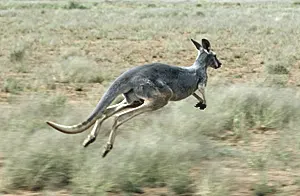
Photo: Kangaroos hopping through grasslands
Kangaroos live in various climates across Australia – from deserts to tropical forests. Different species inhabit different regions.
• Red kangaroo lives mainly in Australia's arid and semi-arid interior.
• Eastern Grey kangaroo inhabits the moist scrublands of the east, south, and south-west regions.
• Western grey kangaroo is found in grasslands and open woodlands in southern Australia.
• Antilopine kangaroo prefers tropical forests with grassy ground cover in the northern regions.
What Do Kangaroos Eat
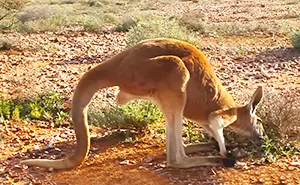
Photo: Kangaroos feeding in Australian Outback
• Kangaroos are herbivores. They feed on various types of vegetation, such as grass, leaves, ferns, flowers, fruit and occasionally moss.
• They prefer feeding at night but also graze early in the morning and late evening during cooler temperatures.
• Kangaroos have a chambered stomach, similar to horses, that helps to digest fibrous plant material that is too tough for other animals to digest. They also regurgitate their food, chew it again and swallow it. This process helps break down the tough fibres in their diet and enhances digestion.
• Kangaroos rarely need to drink water, as they absorb most of the moisture they need from their food.
Did you Know
Kangaroos possess an exceptional ability to sense changes in weather and can detect rainfall from as far as 20 kilometres (12.5 miles) away. They instinctively move towards the rain because they know that new growths of grasses will emerge after the rain.
Kangaroos Reproduction

Photo: Female kangaroo pouch
Kangaroo reproduction is uniquely adapted to the challenges of the Australian environment. Female kangaroos give birth to extremely underdeveloped young—tiny joeys about the size of a jelly bean. Immediately after birth, the joey instinctively crawls into its mother’s pouch, where it latches onto a teat and continues to develop in safety for about six months.
As the joey grows, it begins to peek out of the pouch and take short hops nearby, gradually increasing its independence. By around eight months, it permanently leaves the pouch, though it may continue nursing and stay close to its mother for up to two years.
Female kangaroos can breed year-round, particularly when food is abundant. They reach reproductive maturity at about 16 months, while males mature around 24 months. Unlike females, male kangaroos do not have pouches. In the wild, kangaroos typically live between 22 and 25 years.
Baby Kangaroo Hopping
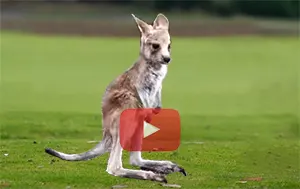
Do Kangaroos Throw Their Babies Away?
No, kangaroos do not throw their babies! It is physically impossible for them to do so with their short arms and hands. However, in cases of extreme danger, a mother may eject her joey from its pouch to distract a predator and allowing her to escape. While it may seem cruel, this desperate move is a natural survival instinct. By sacrificing her baby, the mother saves herself, rather than both mother and baby falling prey to the predator. She can then go on to produce more babies.
How Do Kangaroos Communicate?
Kangaroos have tiny, almost non-existent, vocal cords. A mother communicates with her babies with clicking sounds. An alarmed kangaroo may hiss and growl. A kangaroo may display aggression by making a "ha" sound. A male kangaroo may make a chuckling sound during courtship. Kangaroos also communicate with each other by thumping their feet.
Can Kangaroos Swim?
Kangaroos are surprisingly adept swimmers! Despite the arid habitats they usually live in, kangaroos are often seen swimming in oceans or wading in rivers and watering holes. Their swimming skills are achieved by "dog-paddling" with all four limbs. Kangaroos often flee into watering holes and rivers when threatened.
Can Kangaroos Drown Dogs and Other Predators?
When chased, especially by dogs or dingos, a kangaroo may flee into a waterway, using it as a defensive barrier. If the predator follows the kangaroo into the water, the kangaroo may use its strong arms to grab its assailant and hold it underwater till it drowns.
There have been no reports of kangaroos drowning humans—because, frankly, few people would be reckless enough to chase a kangaroo into deep water.
Do Kangaroos Fight or Box?
Kangaroo Fighting Human
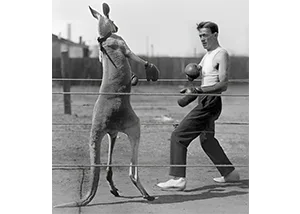
In the past, kangaroos were dressed up in boxing gloves and made to fight humans. This cruel practice is now banned.
Video of Kangaroo Fighting ManKangaroos are not aggressive animals and rarely fight. Instead, fights usually break out over mating rights and are more ritualistic than aggressive. Contrary to popular folklore, kangaroos do not punch or box as humans do. Instead, male kangaroos fight by kicking their opponent with their powerful hind legs and hitting and clawing with their front paws, which have sharp claws. Very rarely do kangaroos hurt each other during these fights.
Kangaroo Predators and Threats What Kills Kangaroos?
Kangaroos are generally safe from predators due to their size, speed and powerful kicks. However, young kangaroos fall prey to eagles, dingoes, foxes and certain dog breeds. Kangaroos rarely succumb to illnesses in their natural habitats. Droughts, motor vehicle accidents, hunting and intentional culling by the government have caused the highest mortality rates for this species.
Are Kangaroos Endangered?
Despite being hunted and culled, kangaroo populations are stable. Australia is home to over 50 million kangaroos, and they’re listed as Least Concern by the IUCN.
Extinct Giant Kangaroos
The procoptodon was a giant short-faced kangaroo that stood about 2m tall and weighed as much as 240kg. It was too heavy to hop and probably walked on its hind legs. It lived in semi-arid areas of South Australia and New South Wales and had a diet of leaves from trees and shrubs. The procoptodons became extinct between 45,000 and 18,000 years ago. Their extinction may have been caused by human hunting, or by human fire-based deforestation in Australia.
25 Kangaroo Facts
- Kangaroos are large-footed hopping marsupials known as macropods.
- Only the four largest macropods are called kangaroos.
- These include the Red, Eastern Grey, Western Grey, and Antilopine kangaroos.
- Kangaroos live throughout Australia, except where there is snow.
- A kangaroo can live for 22-25 years.
- There are twice as many kangaroos as people in Australia.
- The Red Kangaroo can grow to 2.5 m and weigh 90kgs.
- A male kangaroo is called a boomer, a female a flyer, and a baby is called a joey.
- A group of kangaroos is called a mob.
- Kangaroos lick saliva on their arms to keep cool.
- Kangaroos are left-handed.
- Kangaroos hop on their hind legs.
- But it walks on five legs! Yes, that's right. Besides using its front and rear legs, it also uses its tail as a leg.
- Kangaroos thump their feet to warn off predators and other kangaroos of danger.
- A kangaroo can travel long distances at high speed and jump up to three times its own height.
- Kangaroos have very small, almost non-existence vocal cords and can make only a few sounds.
- The kangaroo female carries and nurses its babies in a pouch on its tummy.
- Only female kangaroos have pouches.
- The male kangaroo have a long penis located behind its scrotum.
- The female has three vaginas and two uteruses.
- Kangaroos do environmentally-friendly low-methane farts.
- Kangaroos fight less than most other types of herbivores.
- Contrary to popular folklore, kangaroos do not punch or box like humans do.
- Kangaroos are excellent swimmers.
- Adult kangaroos have few natural predators.
Learn More About Australia’s Wildlife
• Learn About Wallabies, the Kangaroo's Close Cousins →
• Complete Guide to Marsupials →
• Difference Between Marsupials and Mammals →
• More Australian Animals to Discover →

